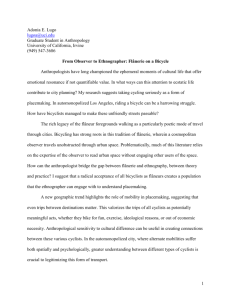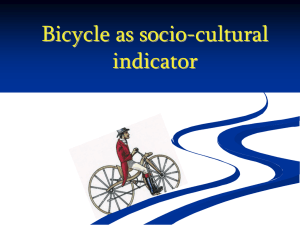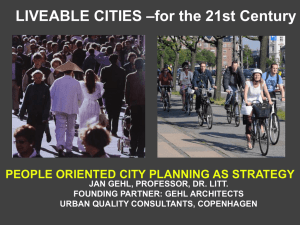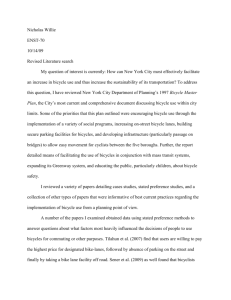New York City Bicycle Law Reforms
advertisement
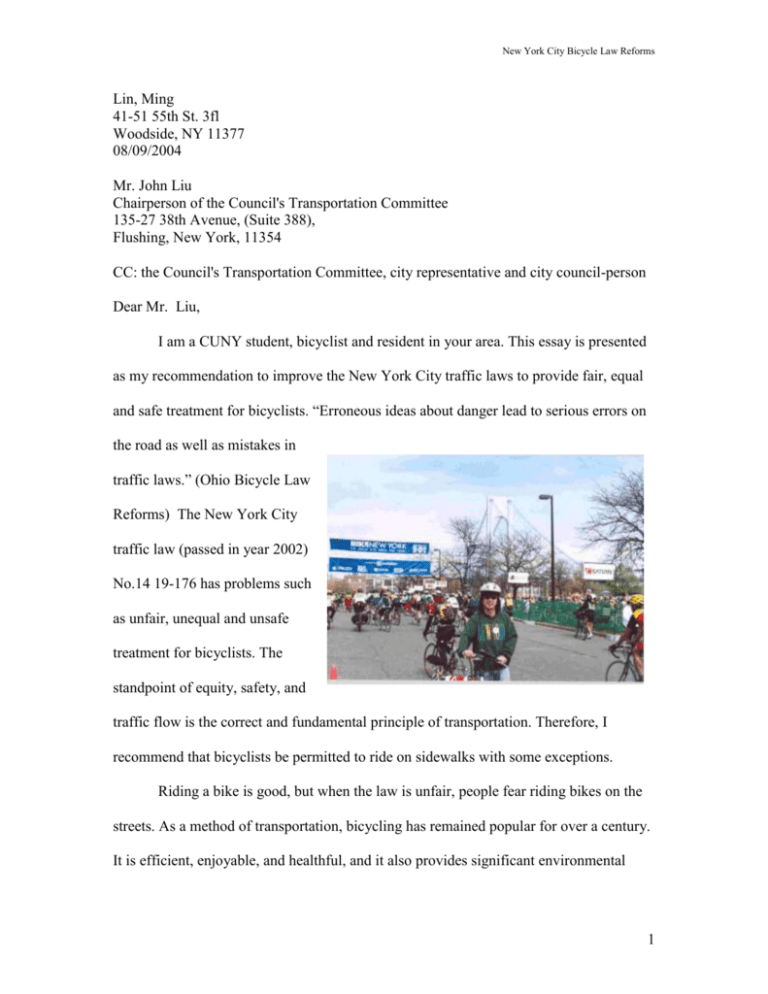
New York City Bicycle Law Reforms Lin, Ming 41-51 55th St. 3fl Woodside, NY 11377 08/09/2004 Mr. John Liu Chairperson of the Council's Transportation Committee 135-27 38th Avenue, (Suite 388), Flushing, New York, 11354 CC: the Council's Transportation Committee, city representative and city council-person Dear Mr. Liu, I am a CUNY student, bicyclist and resident in your area. This essay is presented as my recommendation to improve the New York City traffic laws to provide fair, equal and safe treatment for bicyclists. “Erroneous ideas about danger lead to serious errors on the road as well as mistakes in traffic laws.” (Ohio Bicycle Law Reforms) The New York City traffic law (passed in year 2002) No.14 19-176 has problems such as unfair, unequal and unsafe treatment for bicyclists. The standpoint of equity, safety, and traffic flow is the correct and fundamental principle of transportation. Therefore, I recommend that bicyclists be permitted to ride on sidewalks with some exceptions. Riding a bike is good, but when the law is unfair, people fear riding bikes on the streets. As a method of transportation, bicycling has remained popular for over a century. It is efficient, enjoyable, and healthful, and it also provides significant environmental 1 New York City Bicycle Law Reforms benefits by reducing traffic congestion, noise, fuel consumption, and air pollution. Federal transportation policy under the Intermodal Surface Transportation Efficiency Act [1] now encourages alternative methods of transportation, and Federal and state air quality and congestion management mandates have made non-motorized modes especially attractive. Greater physical activity can also give a substantial contribution to public health. For example, According to the article from T.A. Magazine, “Queens Boulevard is a neighborhood street, not a highway”, during the past 30 years, more than 300 pedestrians have been killed and 5000 seriously injured on the highway-like street called “the human bowling alley”. Bicyclists lack of protection are similar to pedestrians. When I ride on the road, I fear speeding cars every time. When last winter, on a very windy and cold night, I was riding my bike on the sidewalk of Queens Blvd. for just one block which is a short cut to home, but I got a ticket from the police. Since then, I fear car rage and police, and I thought the law needed change. Some states require motorists to pass cyclists at a safe speed and a distance, but this is not so in NYC. The NYC bicycle law NO. 116-A definite “substantial risk of physical injury” as “when a person rides a bicycle on a sidewalk within twenty feet of another person.” The addition of this definition will allow more consistent enforcement of the section’s prohibition.” The law only takes care of people who are on the sidewalks, but it does not take care of bicyclists like other states do. 2 New York City Bicycle Law Reforms Traffic law exists to promote a safe and orderly traffic flow. The law, like traffic flow itself, should be simple, clear, and predictable. Because bicyclists are an easily forgotten minority in an age when most people equate transportation with automobiles, because bicyclists are more vulnerable to injury than motorists, and because bicycling offers significant benefits to society at large, it is especially important for the law to treat bicyclists fairly. It does not do so today. Clarifying the law would increase public respect for alternative modes of transportation, encourage potential bicycle commuters, and improve enforcement, traffic flow, and safety. Secondary effects might include enhanced public physical fitness, reduction in fuel consumption and traffic congestion, improved air quality, and the economic benefits of reduced expenditure—both public and private—on automotive facilities. In New York City, the law makers do not take care of bicyclists, because according to the New York City bicycle law NO. 116-A: “This section was added to ensure that pedestrian safety is not jeopardized by the operation of bicycles on sidewalks. The section prohibits the riding of a bicycle upon any sidewalk unless permitted by an official sign.” The reason for this law is: “The City of New York takes seriously the safety of all those individuals who use its sidewalks. It is for this reason that the City has a multitude of laws and rules relating to ensuring such safety, such as those relating to curbs, vaults and construction sites. Other examples include the bicycle law, which Proposed Int. No. 116-A, to be addressed later in this briefing paper and report, seeks to amend and strengthen, as well as laws and rules relating to the use of scooters, in-line 3 New York City Bicycle Law Reforms skating, and simple mandatory provision for minimum sidewalk clearance for unobstructed pedestrian passage.” I think the problem is not taken seriously the safety of all those bicyclists. Many people believe that a cyclist on the road is in great danger of being hit by passing traffic. So some local governments ban bicycles, particularly from arterial roads such as the Ohio Legislature does not want a cyclist on the road. Many cities build the bike paths on sidewalks. Part of the reason for this problem is that bicycles are toys for children, rather than real vehicles used for transportation. Because “vehicle” does not include a device moved exclusively by human power, a bicycle is not a vehicle for purposes of traffic law. The rule’s purpose is to facilitate traffic flow too, so many motorists are frequently aware of this principle, they think bicyclists delay traffic and sometimes react with anger—and occasionally with belligerent actions—when bicyclists “intrude” onto “their” roads. Many rage driving, speeding and double-parking fear bicycle riders even though they have the same rights as automobile drivers to use the streets. Generally, effective cycling and sharing the road, is all that is needed in slow speed and low volume conditions. However, as motorized speeds and volumes increase, bicyclists need more space and protection from cars, trucks and buses. Other road users often fail to recognize this fundamental principle (and so do councils, police and courts). In fact, “over half of all bicycle injuries and nearly 40% of bicycle fatalities in NY state occur in New York City. In 1983, 20 percent (20%) of all bicycle fatalities in the 4 New York City Bicycle Law Reforms state occurred in New York City. This figure rose to 24 percent in 1984 and 31 percent in 1985. The statistics for the years 1993, 1994 and 1995 are shown in the table below. They represent an increase over the figures from 1983 - 1985. This change is contrary to the downward trend (as noted above) in the statewide statistics.” NUMBER OF NEW YORK CITY BICYCLE-RELATED FATALITIES & INJURIES Fatalities Injuries 1993 1994 1995 1996 1997 1998 Total 14 15 20 16 20 17 102 4,820 4,694 5,378 5,369 5,352 4,911 30,524 39.2% 36.4% 40.8% 32.1% Percentage of Statewide Total: Fatalities 33% 31.9% Figures from 1983 - 1985 were taken from the "New York Statewide Bicycle Advisory Council Report" which was published in 1986. Current figures are taken from New York State Department of Motor Vehicles Summary of Motor Vehicle Accidents (MV-144a). In the nation, there are 85 million bicycle riders. 800 bicyclists die every year, and about 540,000 bicyclists visit emergency rooms with injuries every year. Motor vehicles are involved in 90-92 per cent of bicyclist deaths and 12 per cent of injuries on the roads. Sixty percent of bicycle deaths in 2000 occurred on major roads, and 32 percent occurred on local roads. The bike laws cannot be implemented, be fulfilled and be followed, because it is too simple as there are not exception. New York is not a simple and small city, so the laws cannot be made so simple like knife cutting. There are many 5 New York City Bicycle Law Reforms different situations in New York City such as location (bumper to bumper slow traffic like downtown Time Square or highway-like street but less people use on sidewalks like Queens Blvd.) and time (many people use the streets during rush hours or nobody use sidewalks on hot summer days or cold winter nights, but there are a lot of cars speeding). The reality is that sidewalk travel, by walking, cycling, scootering, in-line skating or otherwise often constitutes the favored option of movement for many individuals in the City. Many people ride bikes on sidewalks, I do not see the police giving them a summon until today, after the law was passed two years ago, but they only gave me a ticket. According to the bicycle law NO. 116-A: “Driving bikes on sidewalks is prohibited unless sign allows or wheels are less than 26 inches in diameter and rider under 14 years of age. See also Administrative Code ¤19-176.” That means the law has exception such as “official sign” and “wheels are less than 26 inches in diameter and rider under 14 years of age.” So many bridges have green ways and parks which are mixed heels and wheels, but they are close less then “twenty feet of another person.” In fact, personally, I have ridden a bike for 14 years in NYC, but I never saw any Bicyclists / Pedestrians problem. According to the report “A Review of Pedestrian Safety Research in the United States and Abroad PUBLICATION NO. 6 New York City Bicycle Law Reforms FHWA-RD-03-042 JANUARY 2004”. There is no Bicyclists / Pedestrians death case. I did a mini survey and asked my friends and classmates about the law, and 90% of them do not know it. Eventhough there is exception such as “official sign” to guide bicyclists use sidewalks or bike paths, but a lot of bridges do not have bike signs such as Roosevelt Avenue bridge and Thomson Avenue bridge. Like other travelers, bicyclists want to reach their destinations safely, conveniently, and with minimum delay. Roadways are often indirect and disconnected; they fail to serve the cyclist’s destination; they may be poorly designed and maintained on the right side of road which are for bikes; and they are usually shared with cars and parking stuffs such as garbage truck carriages or cars. The roadway has less or none of these drawbacks. Although casual bicyclists greatly fear overtaking accidents, such accidents are a major cause of bike-car collisions can reduce, but no body died from bikepedestrian collisions by my knowledge, and there are safety and traffic flow benefits to permitting them to ride there. Bicyclists must have latitude to use their own judgment in determining what is a safe road position, without fear of secondguessing by police officers or courts, because they are the ones who suffer the risk of error. Of course, a bicycle has all the rights and duties of a pedestrian when riding on a sidewalk or cross walk. However, 7 New York City Bicycle Law Reforms bicycles must yield to pedestrians with slow speed while riding in these areas. I think this is a point, but all bikes should not be banned from riding on the all sidewalks. As this article shows, traffic laws, if properly understood, generally leads to reasonable conclusions regarding bicycles. The trouble lies with the difficulty in understanding and carrying out the law. There is no rational basis for the current distinction between bicycles, pedestrians, and vehicles. This distinction is not only confusing in itself, but leads directly to superfluous special regulations for bicycles. These superfluous regulations, in turn, are readily subject to misunderstanding and misinterpretation by police, courts, and motorists, who cannot be expected to carry out the detailed analysis contained in this article. Because bicycles are slow vehicles, localities cannot use their authority to prohibit certain vehicles from particular sidewalks as justification for banning bicycles. If localities were given this authority, they could easily discriminate against bicycles in safety, and exile bicycles to dangerous and inconvenient separated roadways (giving bicyclists’ “safety” as the justification). Because the law is not about safety, has no equality and no reality, I recommend that the law must be changed. Like motorists, bicyclists require flexibility in reacting to traffic conditions. Every person operating a bicycle on the roadway, except under any of the situations listed below, they can ride on the sidewalks: 8 New York City Bicycle Law Reforms • When the sidewalk is not used by people; • When the sidewalk is crossed by a private road or driveway; • When traveling on a one-way road; • When overtaking and passing vehicles in the road; • When necessity or emergency mandates the use of sidewalks. The law is not perfect, and motorists are not perfect; why do the officers treat bicyclists so seriously? I hope you will decide to lead your board to change this bike law that can give cyclists fair, equal and safe treatment. May God bless bicyclists. God bless you, Lin, Ming 9 New York City Bicycle Law Reforms Appendix References 1. The Council of the City of New York. “BRIEFING PAPER AND REPORT OF THE INFRASTRUCTURE DIVISION Amends section 19-176 of title 19. To amend the administrative code of the city of New York, in relation to the operation of bicycles on sidewalks.” New York: 2002. <http://www.nyccouncil.info/issues/committee.cfm?COMMITTEE_ID=79&LTS BDKEY=29&V> 2. Federal Highway Administration. "A Review of Pedestrian Safety Research in the United States and Abroad." PUBLICATION NO. FHWA-RD-03-042 JANUARY 2004. +Turner-Fairbank Highway Research Center 3. HSRC. LaGuardia Community Coll. Lib., Long Island City, NY. 28 July 2004 <http://www.hsrc.unc.edu/publications/publications1.htm> 4. Injuries to Pedestrians and Bicyclists: An Analysis Based on Hospital Emergency Department Data FHWA-RD-99-078 LaGuardia Community Coll. Lib., Long Island City, NY. 23 July 2004 <http://www.health.state.ny.us/nysdoh/research/injury/injury.htm> 5. National Center for Statistics & Analysis Long Island City, NY. 23 July 2004 <http://www-nrd.nhtsa.dot.gov/pdf/nrd-30/NCSA/TSF2002/2002pedfacts.pdf> 6. New York Bicycling Coalition. Albany, NY. 2004. LaGuardia Community Coll. Lib., Long Island City, NY. 26 July 2004 <http://www.nybc.net> 7. The NEW YORK STATE BICYCLE AND PEDESTRIAN PLAN. LaGuardia Community Coll. Lib., Long Island City, NY. 26 July 2004 <http://www.dot.state.ny.us/pubtrans/bapp.pdf> 8. The New York State Department of Health "BICYCLE INJURIES OVERVIEW." LaGuardia Community Coll. Lib., Long Island City, NY. 23 July 2004 <http://www.health.state.ny.us/nysdoh/research/injury/injury.htm> 9. Ohio Bicycle Federation. "Ohio Bicycle Law Reforms." 15 Feb 2004. LaGuardia Community Coll. Lib., Long Island City, NY. 23 July 2004 <http://www.ohiobike.org/ORC_Proposals.htm> 10. "Pedestrian Synthesis Report (2004)." Long Island City, NY. 23 July 2004 <http://www.walkinginfo.org/rd/safety.htm#pedsynth> 10 New York City Bicycle Law Reforms 11. "Statistics from the Insurance Institute for Highway Safety. Fatality Facts: Bicycles" October 2001. LaGuardia Community Coll. Lib., Long Island City, NY. 23 July 2004 < http://www.helmets.org/stats.htm> 12. Transportation Alternatives. “Queens Boulevard is a neighborhood street, not a highway.” T.A. Magazine 2004: Long Island City, NY. 23 July 2004. <http://www.transalt.org/blueprint/chapter17/table17.html> 13. U.S. Department of Transportation: National Highway Traffic Safety Administration. "NHTSA Technical Report" Washington, DC LaGuardia Community Coll. Lib., Long Island City, NY. 27 July 2004 <http://www.tfhrc.gov/safety/pedbike/research/99078/99-078.htm> 14. "University of Florida 2002-2003 Student Guide Campus Safety & Security Bikes on Campus." 23 April, 1999. LaGuardia Community Coll. Lib., Long Island City, NY. 23 July 2004 <http://www.dso.ufl.edu/stg/Traffic_Safety.html> 15. Wachtel, Alan. "Bicycles and the Law: The Case of California." ENVIRONMENTAL LAW AND POLICY JOURNAL 105–124 (May 1995) LaGuardia Community Coll. Lib., Long Island City, NY. 23 July 2004 <http://www.vcbike.org/bikelaw/bikelaw.htm> 11

